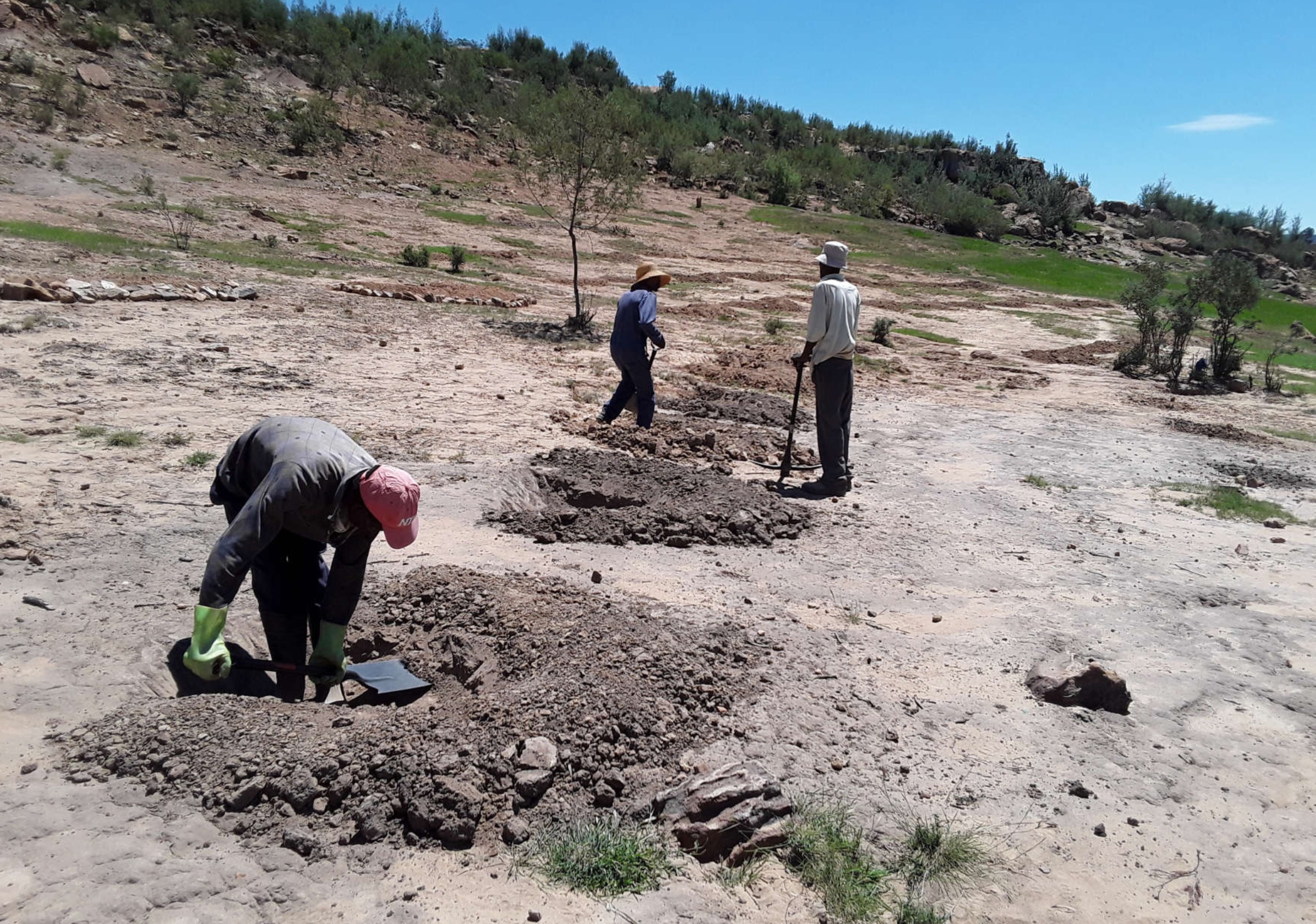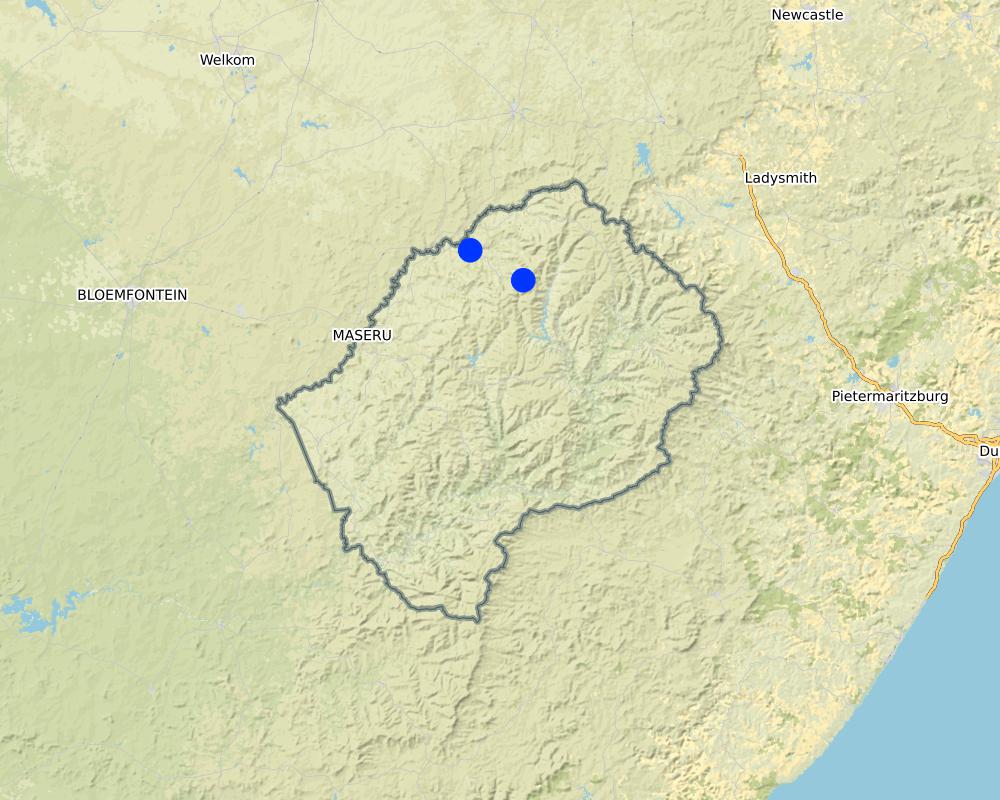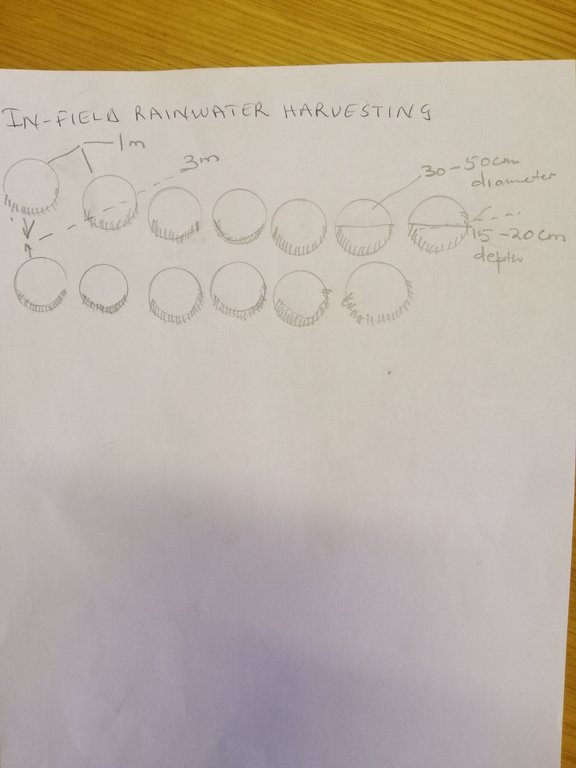In-field rain water harvesting [莱索托]
- 创建:
- 更新:
- 编制者: Matoka Moshoeshoe
- 编辑者: –
- 审查者: Rima Mekdaschi Studer, William Critchley
Infiltration pits
technologies_4591 - 莱索托
查看章节
全部展开 全部收起1. 一般信息
1.2 参与该技术评估和文件编制的资源人员和机构的联系方式
SLM专业人员:
有助于对技术进行记录/评估的项目名称(如相关)
Decision Support for Mainstreaming and Scaling out Sustainable Land Management (GEF-FAO / DS-SLM)有助于对技术进行记录/评估的机构名称(如相关)
Integrated Catchment Management Project (Integrated Catchment Management Project) - 莱索托1.3 关于使用通过WOCAT记录的数据的条件
编制者和关键资源人员接受有关使用通过WOCAT记录数据的条件。:
是
1.4 所述技术的可持续性声明
这里所描述的技术在土地退化方面是否存在问题,导致无法被认为是一种可持续的土地管理技术?:
否
注释:
Its adoption is still at marginal scale since the Department has not yet introduced this technology in all ten(10) administrative districts in the country.
2. SLM技术的说明
2.1 技术简介
技术定义:
The infiltration pits are constructed on bare lands with the aim to enhance re-vegetation of plant species. The pits help to reduce soil erosion/land degradation as water is now able to infiltrate through the pits because they are constructed in succession. It also improves land productivity and cover as well as soil organic carbon.
2.2 技术的详细说明
说明:
The technology is applied on natural marginal environment where the land is dry, they pits are mostly dug on the rangeland. The purpose is to harvest rain water/surface runoff consequently recharge soil moisture and support plant available water as highly as possible. After some time, there will be regeneration of vegetation. The dimensions of this structure may differ according to soil type, slope and rainfall intensity.
To construct this activity, the land should be bare or poor in plant biodiversity. Firstly, the extension workers hold public gatherings for a concerned community to make them aware of the land degradation in their area and possible solutions. In field rain water harvesting pits being one of them. The area is then surveyed using survey equipment (this is a technical survey not the one which uses questionnaires, this survey uses equipment such as theodolyte, auto cat etc). It is important to do the area survey because the technology follows the contour lines, otherwise it is likely to cause more harm on the land. The design of the technology is laid out by using the measuring tape, pick axe and spade. Construction starts from the top of field. Pits are dug in succession in a row following the contour with in row (intrarow) spacing of 1 m, pit depth of 20-30 cm and width of 1 m. Interrow spacing (between rows) is 3 m at 12% slope. After construction, kikuyu grass is sown around the pits to protect them from erosion. After the first storm, the area is then revisited for maintenance and repairs if need be. This technology is beneficial mostly in drylands where the water shortage is a major problem to improve land productivity. Although specififications are in this manner, this technology can be adapted differently in other areas depending on the amount of precipitation received by a certain area. For instance, some pits can be bigger or smaller than the given specifications.
The land users found it beneficial because the inputs needed to construct this technology are locally available such as spade, pick axe and grass for sodding. Furthermore, the rehabilitation benefits accrue within a short while. In addition, the technology is easy to construct. However, the land users found it tedious as they have to maintain it after every storm. The pits can be constructed on the rangeland and cropland which is no longer productive. in this era of climate change where this part of Southern Africa is becoming more dry everyday, this technology is even more applicable.
2.3 技术照片
2.4 技术视频
注释、简短说明:
N/A
日期:
26/03/2019
位置:
N/A
摄影师的名字:
N/A
2.5 已应用该技术的、本评估所涵盖的国家/地区/地点
国家:
莱索托
区域/州/省:
Leribe District
有关地点的进一步说明:
Peri-Urban
具体说明该技术的分布:
- 适用于特定场所/集中在较小区域
技术现场是否位于永久保护区?:
否
注释:
The activity is currently being scaled up/out in sub-catchments at sub-national level of which the areas are communally owned
Map
×2.6 实施日期
注明实施年份:
2019
2.7 技术介绍
详细说明该技术是如何引入的:
- 通过项目/外部干预
注释(项目类型等):
DS-SLM project pilot stage facilitated the adoption of the innovation
3. SLM技术的分类
3.1 该技术的主要目的
- 改良生产
- 减少、预防、恢复土地退化
- 保护生态系统
- 保持/提高生物多样性
- 降低灾害风险
3.2 应用该技术的当前土地利用类型
同一土地单元内混合使用的土地::
是
具体说明混合土地使用(作物/放牧/树木):
- 林牧业

牧场
粗放式放牧:
- 半游牧畜牧业
- deferred grazing
动物类型:
- 牲畜 - 其他小型动物
是否实行作物与牲畜的综合管理?:
否
产品和服务:
- 交通工具/役畜
品种:
牛 - 非奶牛牛肉
计数:
207
品种:
绵羊
计数:
1307

森林/林地
- 植树造林
植树造林:说明树种的起源和组成:
- 单一栽培的外来品种
植树造林类型:
- 亚热带旱林人工林
树木类型:
- 金合欢树种
- Acacia dealbata
以上的树木是落叶树还是常绿树?:
- 混合落叶或常绿
产品和服务:
- 薪材

定居点、基础设施
- 定居点、建筑物
注释:
settlement encroachment into range-lands
注释:
Nearby waterways are natural and there are also seasonal streams full of fine sand which is currently mined. The mining of sand threatens stream banks thereby accelerating further erosion within the catchment boundaries. The sand mine is not directly where the SLM practices are practiced, but on the edge/boundaries and it will contribute to widening of gullies within this catchment in future.
3.3 由于技术的实施,土地使用是否发生了变化?
由于技术的实施,土地使用是否发生了变化?:
- 否(继续问题3.4)
3.4 供水
该技术所应用土地的供水:
- 雨养
注释:
The area is very dry
3.5 该技术所属的SLM组
- 天然和半天然森林管理
- 畜牧业和牧场管理
- 引水和排水
3.6 包含该技术的可持续土地管理措施

农艺措施
- A1:植被和土壤覆盖层
- A2:有机质/土壤肥力
- A6:残株管理

植物措施
- V2:草和多年生草本植物
- V4:更换或清除外来/入侵物种

结构措施
- S3:分级沟渠、渠道、水道
- S4:平沟、坑

管理措施
- M1:改变土地使用类型
- M2:改变管理/强度级别
- M5:物种组成的控制/变化
注释:
This technology is practised on the rangeland, where the land is bare or has little vegetative cover. The aim of this technology is to collect as much rainwater as possible, to facilitate regeneration of vegetation so that ultimately the bare land/rangeland will have cover.
3.7 该技术强调的主要土地退化类型

土壤水蚀
- Wt:表土流失/地表侵蚀
- Wg:冲沟侵蚀/沟蚀
- Wm:块体运动/滑坡
- Wr:河岸侵蚀

化学性土壤退化
- Cn:肥力下降和有机质含量下降(非侵蚀所致)
- Cs:盐化/碱化

物理性土壤退化
- Pc:压实
- Pk:熟化和结壳
- Pi:覆土
- Pw:水浸
- Pu:由于其他活动而导致生物生产功能的丧失

生物性退化
- Bc:植被覆盖的减少
- Bh:栖息地丧失
- Bq:数量/生物量减少
- Bf:火灾的有害影响
- Bs:质量和物种组成/多样性的下降
- Bl:土壤寿命损失

水质恶化
- Ha:干旱化
- Hp:地表水水质下降
注释:
The technology addresses several types of land degradation when implemented properly.
3.8 防止、减少或恢复土地退化
具体数量名该技术与土地退化有关的目标:
- 减少土地退化
- 修复/恢复严重退化的土地
注释:
Lesotho's landscape is continuously becoming bare owing to the impacts of land degradation, desertification and drought. This technology has been used effectively to counter the impacts of land degradation.
4. 技术规范、实施活动、投入和成本
4.1 该技术的技术图纸
技术规范(与技术图纸相关):
Technical specifications:
Dimensions; height 20cm, depth 30cm, width 1m and length 1m
Spacing between structures; between rows 5m, between pits 3m
slope; 3-12%
construction material used; stones, soil, grass sodds , mulch and compost and grass seeds
6 litres is the water holding capacity of a pit
作者:
Matoka Moshoeshoe, Koetlisi Koetlisi and Mamofota Lekholoane
日期:
01/04/2015
4.2 有关投入和成本计算的一般信息
具体说明成本和投入是如何计算的:
- 每个技术区域
注明尺寸和面积单位:
0.2 ha
如果使用本地面积单位,注明转换系数为1公顷(例如1公顷=2.47英亩):1公顷=:
N/A
具体说明成本计算所用货币:
- 美元
注明雇用劳工的每日平均工资成本:
4.6 US dollars
4.3 技术建立活动
| 活动 | 时间(季度) | |
|---|---|---|
| 1. | public awareness raising gathering | winter |
| 2. | survey of area/ terrain | winter |
| 3. | design and laying out of infiltration pits | winter |
| 4. | implementation/construction of pits | winter |
| 5. | sowing | winter and or summer |
| 6. | maintenance | when need arises |
注释:
Due to impacts of climate change, the activity logistics could be done any-time as long as meteorological predictions allow
4.4 技术建立所需要的费用和投入
| 对投入进行具体说明 | 单位 | 数量 | 单位成本 | 每项投入的总成本 | 土地使用者承担的成本% | |
|---|---|---|---|---|---|---|
| 劳动力 | one person | person-days | 1.0 | 5.0 | 5.0 | 5.0 |
| 设备 | pick axe | piece | 1.0 | 15.0 | 15.0 | |
| 设备 | spade | piece | 1.0 | 13.0 | 13.0 | |
| 设备 | measuring tape | piece | 1.0 | 8.0 | 8.0 | |
| 植物材料 | grass seed | kg | 2.0 | 13.0 | 26.0 | 25.0 |
| 施工材料 | stones | piece | 40.0 | 1.0 | 40.0 | |
| 技术建立所需总成本 | 107.0 | |||||
| 技术建立总成本,美元 | 107.0 | |||||
如果土地使用者负担的费用少于100%,请注明由谁负担其余费用:
Government
注释:
There are no costs incurred by land users bacause the rate of erosion is massive and highly costly therefore, farmers cannot afford to protect their own land without government intervention. The landowner simply contributes in-kind not in cash by maintaining that piece of land after rehabilitation.
4.5 维护/经常性活动
| 活动 | 时间/频率 | |
|---|---|---|
| 1. | public gathering | after storm |
| 2. | re-survey | after storm |
| 3. | implementation | after storm |
注释:
all maintenance works done after storm
4.6 维护/经常性活动所需要的费用和投入(每年)
| 对投入进行具体说明 | 单位 | 数量 | 单位成本 | 每项投入的总成本 | 土地使用者承担的成本% | |
|---|---|---|---|---|---|---|
| 劳动力 | grass seed | kg | 1.0 | 13.0 | 13.0 | |
| 劳动力 | one person | person day | 1.0 | 5.0 | 5.0 | |
| 技术维护所需总成本 | 18.0 | |||||
| 技术维护总成本,美元 | 18.0 | |||||
如果土地使用者负担的费用少于100%,请注明由谁负担其余费用:
Government
注释:
maintenance is done by both community and government
4.7 影响成本的最重要因素
描述影响成本的最决定性因素:
Government annual budget affects inputs and labour
5. 自然和人文环境
5.1 气候
年降雨量
- < 250毫米
- 251-500毫米
- 501-750毫米
- 751-1,000毫米
- 1,001-1,500毫米
- 1,501-2,000毫米
- 2,001-3,000毫米
- 3,001-4,000毫米
- > 4,000毫米
指定年平均降雨量(若已知),单位为mm:
735.00
有关降雨的规范/注释:
The Northern parts of the country receive good amount of rainfall generally. This is the place where generally soils are also good and agricultural production is satisfactory so far.
注明所考虑的参考气象站名称:
Hlotse
农业气候带
- 半干旱
The climate in this region favours agricultural production more than anything else. The Leribe district was once referred to as the bread basket of the country simply because the climate and soils are good for both crop and animal production.
5.2 地形
平均坡度:
- 水平(0-2%)
- 缓降(3-5%)
- 平缓(6-10%)
- 滚坡(11-15%)
- 崎岖(16-30%)
- 陡峭(31-60%)
- 非常陡峭(>60%)
地形:
- 高原/平原
- 山脊
- 山坡
- 山地斜坡
- 麓坡
- 谷底
垂直分布带:
- 0-100 m a.s.l.
- 101-500 m a.s.l.
- 501-1,000 m a.s.l.
- 1,001-1,500 m a.s.l.
- 1,501-2,000 m a.s.l.
- 2,001-2,500 m a.s.l.
- 2,501-3,000 m a.s.l.
- 3,001-4,000 m a.s.l.
- > 4,000 m a.s.l.
说明该技术是否专门应用于:
- 不相关
关于地形的注释和进一步规范:
The slope is moderate to gentle as the area extends towards the stream bank where there is depression. Above the area where the technology is implemented, there is a plateau where the community lives. However, the whole area is within a valley.
5.3 土壤
平均土层深度:
- 非常浅(0-20厘米)
- 浅(21-50厘米)
- 中等深度(51-80厘米)
- 深(81-120厘米)
- 非常深(> 120厘米)
土壤质地(表土):
- 粗粒/轻(砂质)
土壤质地(地表以下> 20厘米):
- 中粒(壤土、粉土)
表土有机质:
- 低(<1%)
如有可能,附上完整的土壤描述或具体说明可用的信息,例如土壤类型、土壤酸碱度、阳离子交换能力、氮、盐度等。:
Soil type was not classified, a detailed soil type map of Lesotho can be found at https://lesis.gov.ls
5.4 水资源可用性和质量
地下水位表:
5-50米
地表水的可用性:
中等
水质(未处理):
良好饮用水
水质请参考::
地下水和地表水
水的盐度有问题吗?:
否
该区域正在发生洪水吗?:
否
关于水质和水量的注释和进一步规范:
There are natural springs which have have been developed by village water supply for community to access safe drinking water. There are seasonal streams around the area which communities use for washing and animal drinking.
5.5 生物多样性
物种多样性:
- 低
栖息地多样性:
- 低
关于生物多样性的注释和进一步规范:
The area is mainly used as a range-land which is not given time to rest. Re-vegetation occurs very slowly due to mismanagement of the land.
5.6 应用该技术的土地使用者的特征
定栖或游牧:
- 半游牧的
生产系统的市场定位:
- 生计(自给)
非农收入:
- 低于全部收入的10%
相对财富水平:
- 平均水平
个人或集体:
- 个人/家庭
- 团体/社区
机械化水平:
- 手工作业
- 畜力牵引
性别:
- 女人
- 男人
土地使用者的年龄:
- 中年人
- 老年人
说明土地使用者的其他有关特征:
The land is used mainly for crop and animal production although there are signs of settlement encroachment.
5.7 应用该技术的土地使用者使用的平均土地面积
- < 0.5 公顷
- 0.5-1 公顷
- 1-2 公顷
- 2-5公顷
- 5-15公顷
- 15-50公顷
- 50-100公顷
- 100-500公顷
- 500-1,000公顷
- 1,000-10,000公顷
- > 10,000公顷
这被认为是小规模、中规模还是大规模的(参照当地实际情况)?:
- 小规模的
注释:
The area was used as a demonstration site. The technology is yet to be up-scaled to other areas.
5.8 土地所有权、土地使用权和水使用权
土地所有权:
- 社区/村庄
- 个人,有命名
土地使用权:
- 自由进入(无组织)
- 社区(有组织)
用水权:
- 自由进入(无组织)
- 社区(有组织)
土地使用权是否基于传统的法律制度?:
是
注释:
According to the Land Act of 2010, land in Lesotho is vested in the Basotho nation and is held in trust by the King.
5.9 进入服务和基础设施的通道
健康:
- 贫瘠
- 适度的
- 好
教育:
- 贫瘠
- 适度的
- 好
技术援助:
- 贫瘠
- 适度的
- 好
就业(例如非农):
- 贫瘠
- 适度的
- 好
市场:
- 贫瘠
- 适度的
- 好
能源:
- 贫瘠
- 适度的
- 好
道路和交通:
- 贫瘠
- 适度的
- 好
饮用水和卫生设施:
- 贫瘠
- 适度的
- 好
金融服务:
- 贫瘠
- 适度的
- 好
注释:
The area is found in the peri-urban zone which is near the major town of Hlotse. There are access roads and they are closer to markets.
6. 影响和结论性说明
6.1 该技术的现场影响
社会经济效应
生产
饲料生产
SLM之前的数量:
vegetation cover was poor
SLM之后的数量:
increased vegetation cover
注释/具体说明:
quantity increased after SLM
饲料质量
SLM之前的数量:
fodder quality was also poor
SLM之后的数量:
increased quality
注释/具体说明:
There is now fodder available for animals
土地管理
SLM之前的数量:
land was poorly managed
SLM之后的数量:
community members agreed to protect the land
注释/具体说明:
The pits constructed have contributed positively to increase in land cover, land productivity and soil organic carbon
社会文化影响
食品安全/自给自足
SLM之前的数量:
animals were too weak
SLM之后的数量:
the quality of stock improved
注释/具体说明:
The technology has contributed positively towards availability of fodder hence good animal production
娱乐机会
SLM之前的数量:
biodiversity was lost
SLM之后的数量:
regeneration of biodiversity
注释/具体说明:
both birds and wild animals are now occupying the habitat, communities use rehabilitated areas as parks or picnic area, and people pay to access that part of the land. The revenue collected will then be used for other purposes that might help community such as fixing a broken water tap etc.
SLM/土地退化知识
SLM之前的数量:
community members did not have knowledge of the technology
SLM之后的数量:
community members can now construct the pits on their own in their own land
注释/具体说明:
knowledge on land degradation now improved
生态影响
水循环/径流
水的回收/收集
SLM之前的数量:
water was not collected
SLM之后的数量:
surface run-off was now collected
注释/具体说明:
a lot of water is now collected through this technology and not lost like it used to be
地表径流
SLM之前的数量:
surface runoff was not controlled
SLM之后的数量:
surface run-off was partly collected
注释/具体说明:
surface run-off now partly collected and soil erosion minimised
多余水的排放
SLM之前的数量:
poor surface drainage
SLM之后的数量:
infiltration improved drainage
注释/具体说明:
surface drainage was controlled to enhance infiltration
土壤
土壤水分
SLM之前的数量:
prolonged dry-moist dry
SLM之后的数量:
conditional moisture
注释/具体说明:
improved
土壤覆盖层
SLM之前的数量:
the land was bare
SLM之后的数量:
revegetation
注释/具体说明:
improved vegetation abundance
土壤流失
SLM之前的数量:
sheet erosion
SLM之后的数量:
sheet erosion disrupted
注释/具体说明:
surface roughness improved
土壤堆积
SLM之前的数量:
much soil loss
SLM之后的数量:
sedimentation improved
注释/具体说明:
sediment is collected in ditches
生物多样性:植被、动物
生物量/地上C
SLM之前的数量:
bare ground
SLM之后的数量:
above ground biomass improved
注释/具体说明:
improved soil moisture supports biomass production
植物多样性
SLM之前的数量:
few species
SLM之后的数量:
species variety
注释/具体说明:
various species require availed prolonged soil moisture
对现场影响的评估(测量)进行具体说明:
general biodiversity improved
6.2 该技术的场外影响已经显现
温室气体的影响
SLM之前的数量:
less carbon stored in the soil
SLM之后的数量:
improved carbon sequestration
注释/具体说明:
soil organic carbon improved
对场外影响(测量)的评估进行具体说明:
the activity is likely to be up-scaled
6.3 技术对渐变气候以及与气候相关的极端情况/灾害的暴露和敏感性(土地使用者认为的极端情况/灾害)
渐变气候
渐变气候
| 季节 | 增加或减少 | 该技术是如何应对的? | |
|---|---|---|---|
| 年温度 | 增加 | 好 | |
| 季雨量 | 夏季 | 增加 | 适度 |
气候有关的极端情况(灾害)
气象灾害
| 该技术是如何应对的? | |
|---|---|
| 局地雷暴 | 非常好 |
| 局地雹灾 | 好 |
水文灾害
| 该技术是如何应对的? | |
|---|---|
| 山洪暴发 | 好 |
注释:
The technology works very well when there is surface run-off as the main aim is to collect as much of run-off as possible for moisture retention.
6.4 成本效益分析
技术收益与技术建立成本相比如何(从土地使用者的角度看)?
短期回报:
中性/平衡
长期回报:
积极
技术收益与技术维护成本/经常性成本相比如何(从土地使用者的角度看)?
短期回报:
轻度消极
长期回报:
中性/平衡
注释:
the technology can easily be maintained although maintenance plan does not exist
6.5 技术采用
- 11-50%
如若可行,进行量化(住户数量和/或覆盖面积):
sixty
在所有采用这项技术的人当中,有多少人是自发的,即未获得任何物质奖励/付款?:
- 0-10%
注释:
land users who own the land relative to those to those who have user rights only, saw the importance of the technology
6.6 适应
最近是否对该技术进行了修改以适应不断变化的条件?:
是
若是,说明它适应了哪些变化的条件:
- 气候变化/极端气候
具体说明技术的适应性(设计、材料/品种等):
the dimensions differ relative to the rainfall intensity, soil type and technician and land user preference
6.7 该技术的优点/长处/机会
| 土地使用者眼中的长处/优势/机会 |
|---|
| the technology is implemented by both men and women |
| Middle-aged and elderly group were impressed with the technology |
| the technology uses locally available inputs |
| 编制者或其他关键资源人员认为的长处/优势/机会 |
|---|
| it is environmentally friendly |
| it helps in achieving variuos LDN targets |
| it can be demonstrated to a large group of people at once |
6.8 技术的弱点/缺点/风险及其克服方法
| 土地使用者认为的弱点/缺点/风险 | 如何克服它们? |
|---|---|
| they could be easily destroyed by single hailstorm | trenches be constructed to lower velocity and discharge of surface run-off |
| they could conditionally be filled with sediment | sediments should be removed periodically |
| 编制者或其他关键资源人员认为的弱点/缺点/风险 | 如何克服它们? |
|---|---|
| they could be easily destroyed by single hailstorm | trenches be constructed to lower velocity and discharge of surface run-off |
7. 参考和链接
7.1 信息的方法/来源
- 实地考察、实地调查
sixty
(现场)数据是什么时候汇编的?:
18/02/2019
注释:
A public gathering/focus group discussion was held on site, community members were sensitised by extension workers from the Ministry of Forestry and its Line Ministries (Ministry of Agriculture, Ministry of Water, Ministry of Local Government) on the importance of the technology. Demonstrations were held after the public was informed about the importance of the technology.
7.2 参考可用出版物
标题、作者、年份、ISBN:
In-field rainwater harvesting: Conservation of your natural resources through in-field rainwater harvesting, Jacobus Botha, [2012]
可以从哪里获得?成本如何?
Agricultureal Research Council, Institute for Soil, Climate and Water (ARC-SCW), South Africa
7.3 链接到网络上的相关信息
标题/说明:
Agricultural Research Council, South Africa
URL:
www.arc.agric.za
7.4 一般注释
other information regarding this technology was deduced from the report from Larry C. Tennyson, 2012
链接和模块
全部展开 全部收起链接
无链接
模块
无模块







